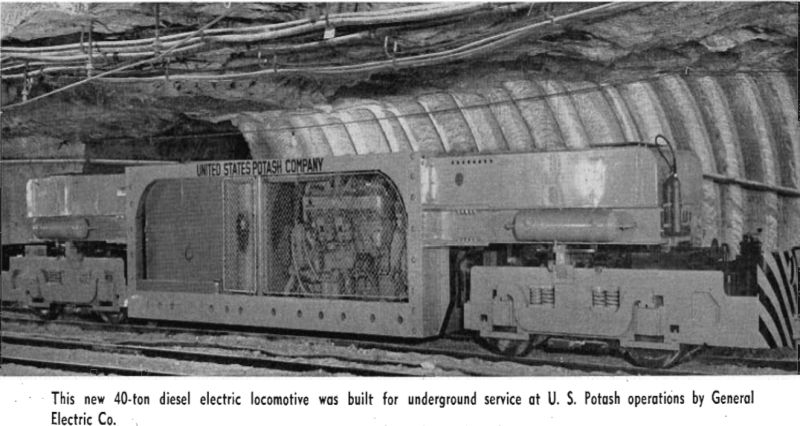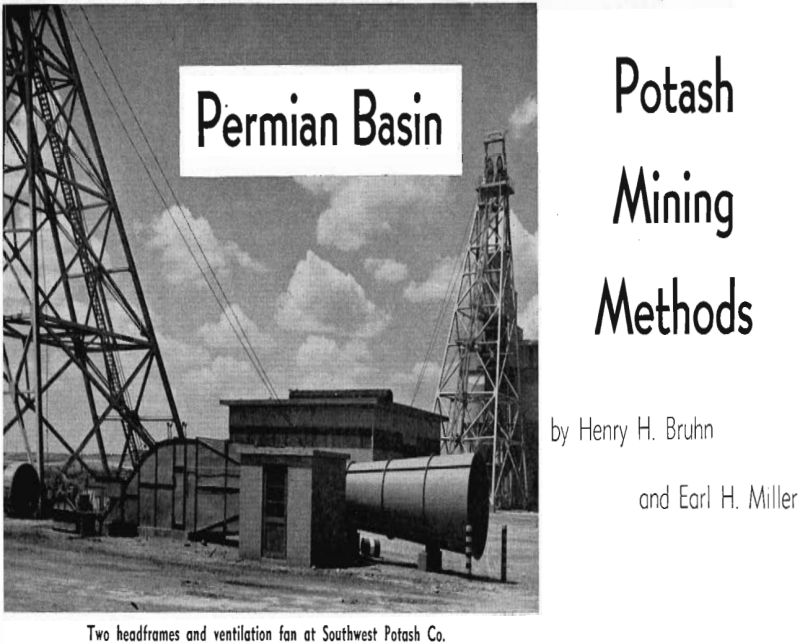Table of Contents
Commercial beds of sylvite ore were discovered by the Snowden & McSweeney Co. while drilling a wildcat oil well some 25 miles northeast of Carlsbad, N. M., in 1925.
After a preliminary core drilling program the U. S. Potash Co. sank a 1060-ft shaft within 4 miles of the original discovery. This shaft was in an isolated location in a sand desert area with only the roughest of dirt roads connecting it with the neighboring town of Carlsbad some 21½ miles west.
Since little was known in this country of potash mining method, original development was based on metal mining practice. The first shaft was a four-compartment timbered shaft, the hoisting compartments being 66 in. by 46 in. between the guides.
Drilling and Blasting
Blast hole drilling is done with post-mounted auger type coal drills and Joy CD-34 drills which were first developed for potash use at the U. S. Potash Co. property. The Joy CD-34 is a two-drill hydraulically operated machine with a capacity of 10 fpm per drill. Double-tipped tungsten carbide auger type drill bits are used. A later development using hollow drill steel with an auger type bit and compressed air to remove drill cuttings has also proven quite successful. Alloy steel detachable cutters and tungsten carbide tips are used on the post-mounted auger type drills. One and one half in. bottom diam holes for a 1×8 in., 40 pct ammonia dynamite are present practice. An average 9×36-ft face is drilled with 50 holes. The drill pattern calls for five rows of ten holes, the top row of holes is drilled horizontally or slightly upward, and each succeeding row points downward at a steeper angle with the lower row of holes bottoming within 9 in. of the back of the undercut.
After blasting, ore is loaded with Joy 11 BU loading machines into Joy 60E shuttle cars which move the ore to an elevating conveyor which loads the 4-ton Granby type ore cars at the rail head. A few Joy 14 BU loaders are used in thin seam mining with Joy 32E and 42D shuttle cars but the major work is done with high equipment.
Haulage
Ore is hauled to pockets at the No. 1 shaft on 24- in. gage track by various types of electric trolley locomotives. These units vary in weight from 6 to 20 tons each and are all of the 4-wheel type. The latest 15-ton GE electric locomotives purchased are designed to be run either separately or in tandem and have a 7500-lb drawbar pull at 10.5 mph. Controls on these locomotives are so designed that up to four or more of them can be coupled in tandem and operated from one control point, permitting adjustment of motive power to any grade or tonnage.
There are about 200 miles of open workings at the U. S. Potash Co. Studies have been carried on over the years, showing an average convergence in the older workings of about ½ in. per year. On a few occasions floor bursts have occurred, presumably caused by trapped pockets of high pressure nitrogen gas combined with pillar pressure on either side of the break. At some locations in the mine, floors have shown a tendency to bulge upward in the center, probably due to pillar pressure on softer underlying strata.
Three Joy continuous miners have recently been put into service at U. S. Potash properties. These machines are the standard Joy coal mining machines and on first trial have shown many weaknesses for the much heavier duty required in mining potash ore. Weak points are being redesigned and indications are that continuous mining may become a standard practice in sylvite mining.


Ventilation
Ventilation at this mine is done by Jeffrey reversible Axivane fans. Normally all mine air is moved by a fan located underground near the foot of No. 2 shaft, but in case of an emergency, a fan located at the surface of No. 2 shaft can be put in service by dropping temporary trap doors over the top of the shaft and using this surface fan as a suction fan. A third fan was installed in the return air-way of the two north entries to serve as a booster in ventilating the extreme end of the north development. Now, 158,000 cfm is being moved through the mine workings with the air flow directed by American Mine Door Co. automatic doors mounted in certain of the main haulageways.
Ventilation has been somewhat complicated by the large area mined and because long double-entry haulageways are being driven to connect the No. 3 shaft to the north. Diesel equipment is being used in these haulageways and return air from this part of the operation is diverted through certain worked- out areas in the mine and brought back to upcast shaft No. 2. This return air is so routed that it never passes working faces in the mine.
Potash Co. of America
Potash Co. of America, the second operator in the area, began shipment of crude ore in 1934. Its beds are generally flat lying, and mining practice consists of setting up extraction panels averaging 1800 x 1200 ft, with rooms and breakthroughs on 65-ft centers. Rooms are driven 28 ft wide, leaving 37-ft sq pillars. This results in an initial mining extraction of approximately 65 pct and practically no timbering or roof bolting is required.
Undercutting with 9-ft shortwall machines is done using standard tungsten carbide undercutter bits, the cut being made in the salt bed immediately below the bottom of the ore. Some drilling is done with auger type post-mounted coal drills, but the greater part is done with a.drill jumbo developed by the company. This pneumatic tired jumbo mounts two drills, each on an independently operated arm, and is capable of drilling at a rate of 5 fpm with one operator on each drill. Holes are drilled to an average depth of 10 ft and varying hole patterns are used, depending on the height of the face, the average round having 30 holes. Ammonium nitrate explosives and millisecond delay primers are used. The bottom row and the lower half of a center V-cut pattern is fired first with the following order of firing progressing out and up with the top rib holes being fired last. Semipermanent blasting lines are installed in working panels and all the loaded faces in a working section are fired simultaneously from a central switch at the end of each shift after all of the men have been checked into the mantrip.

